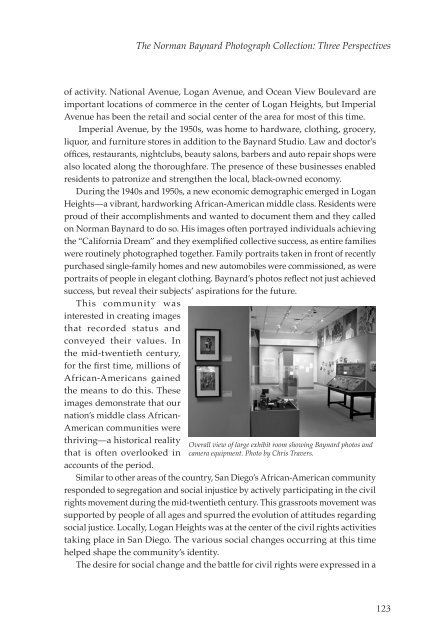Summer 2011, Volume 57, Number 3 - San Diego History Center
Summer 2011, Volume 57, Number 3 - San Diego History Center
Summer 2011, Volume 57, Number 3 - San Diego History Center
Create successful ePaper yourself
Turn your PDF publications into a flip-book with our unique Google optimized e-Paper software.
The Norman Baynard Photograph Collection: Three Perspectives<br />
of activity. National Avenue, Logan Avenue, and Ocean View Boulevard are<br />
important locations of commerce in the center of Logan Heights, but Imperial<br />
Avenue has been the retail and social center of the area for most of this time.<br />
Imperial Avenue, by the 1950s, was home to hardware, clothing, grocery,<br />
liquor, and furniture stores in addition to the Baynard Studio. Law and doctor’s<br />
offices, restaurants, nightclubs, beauty salons, barbers and auto repair shops were<br />
also located along the thoroughfare. The presence of these businesses enabled<br />
residents to patronize and strengthen the local, black-owned economy.<br />
During the 1940s and 1950s, a new economic demographic emerged in Logan<br />
Heights—a vibrant, hardworking African-American middle class. Residents were<br />
proud of their accomplishments and wanted to document them and they called<br />
on Norman Baynard to do so. His images often portrayed individuals achieving<br />
the “California Dream” and they exemplified collective success, as entire families<br />
were routinely photographed together. Family portraits taken in front of recently<br />
purchased single-family homes and new automobiles were commissioned, as were<br />
portraits of people in elegant clothing. Baynard’s photos reflect not just achieved<br />
success, but reveal their subjects’ aspirations for the future.<br />
This community was<br />
interested in creating images<br />
that recorded status and<br />
conveyed their values. In<br />
the mid-twentieth century,<br />
for the first time, millions of<br />
African-Americans gained<br />
the means to do this. These<br />
images demonstrate that our<br />
nation’s middle class African-<br />
American communities were<br />
thriving—a historical reality<br />
that is often overlooked in<br />
accounts of the period.<br />
Overall view of large exhibit room showing Baynard photos and<br />
camera equipment. Photo by Chris Travers.<br />
Similar to other areas of the country, <strong>San</strong> <strong>Diego</strong>’s African-American community<br />
responded to segregation and social injustice by actively participating in the civil<br />
rights movement during the mid-twentieth century. This grassroots movement was<br />
supported by people of all ages and spurred the evolution of attitudes regarding<br />
social justice. Locally, Logan Heights was at the center of the civil rights activities<br />
taking place in <strong>San</strong> <strong>Diego</strong>. The various social changes occurring at this time<br />
helped shape the community’s identity.<br />
The desire for social change and the battle for civil rights were expressed in a<br />
123







![[PDF] The Journal of San Diego History Vol 52: Nos 1 & 2](https://img.yumpu.com/25984149/1/172x260/pdf-the-journal-of-san-diego-history-vol-52-nos-1-2.jpg?quality=85)

![[PDF] The Journal of San Diego History - San Diego History Center](https://img.yumpu.com/25984131/1/172x260/pdf-the-journal-of-san-diego-history-san-diego-history-center.jpg?quality=85)







